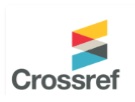Detection of Hepatitis B Virus (HBV) Genotypes by Nested Polymerase Chain Reaction (PCR) Technique in Diyala Province
DOI:
https://doi.org/10.24237/ASJ.01.04.640BAbstract
Hepatitis B virus (HBV) infection is a public health concern because it causes liver diseases
such as hepatocellular carcinoma and liver cirrhosis. Depending on the virus sequence
homogeneity, ten HBV genotypes (A-J) were identified. The aim of this study is the molecular
and serological detection of HBV utilizing the nested polymerase chain reaction (PCR)
technique, and biochemical test for liver function to estimate the levels of alanine
aminotransferase (ALT), aspartate aminotransferase (AST) and Alkaline phosphatase (ALP).
A cross-sectional study was conducted in170 reviewers (103 males and 67 females) who
attended the Baquba Teaching Hospital, Teaching laboratories, the Main Blood Bank, and
Baladrooz General Hospital. Age ranging 13-75 years. The samples were collected from Diyala
Province of Iraq, Enzyme- Linked Immune Sorbent Assay test (ELISA) was used to detect
hepatitis B surface antigen (HBsAg) in serum. Automated machine (Mindray Bs-240 system)
for quantitative determination of (ALT, AST, ALP) was used. Conventional Polymerase Chain
Reaction (PCR) of HBV p gene was performed for HBV- DNA detection from serum samples,
and Nested PCR technique with specific primers was used to detect HBV genotypes. Results
of ELISA showed that 70 (41.20%) samples were positive and 100 (58.80%) samples were
negative. PCR results showed that 14 (8.20%) samples were positive for HBV- DNA.
Statistically, the positivity of HBV detected by ELISA was higher (41.2%) than positivity of HBV detected by PCR (8.20%). Liver function test found the levels of ALT (36.31±12.00),
AST (47.92±21.00) ALP (100.24±45.92) was high in patients than controls. ALP and AST
scored the highest sensitivity than ALT, while based on specificity, ALT and ALP scored the
highest specificity than AST.
Downloads
Downloads
Published
Issue
Section
License
Copyright (c) 2023 CC BY 4.0

This work is licensed under a Creative Commons Attribution 4.0 International License.





